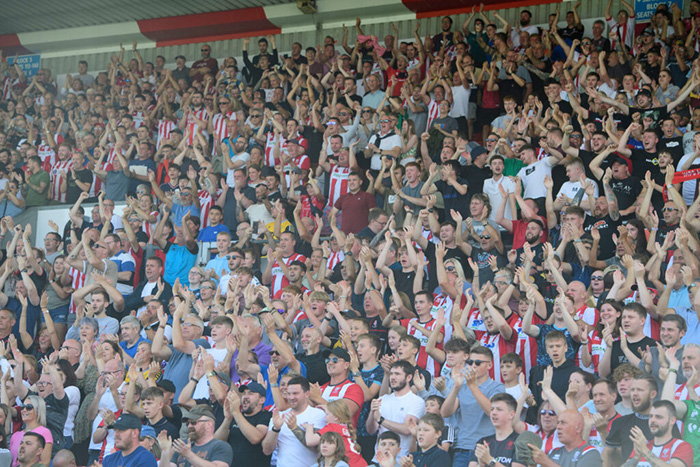Safe Standing Fan Engagement – Lincoln City FC Case Study

With Lincoln City Football Club being a Voluntary All‑Seater ground, the Sports Grounds Safety Authority (SGSA) is keen to highlight the work the club has been doing to engage with fans on persistent standing as a case study of good practice in favour of licensed/safe standing to address spectator demand for such areas.
From the extensive technical research conducted, to the thorough engagement with fans, the club has been doing some great work to identify the need and amount of standing areas at the ground.
Lincoln City begun taking voluntary action in tackling the level of persistent standing occurring at the ground in order to improve safety and fan experience in their well‑established ‘singing section’. The club also wanted to take proactive steps following SGSA’s ‘early adopter’ research of licensed standing areas in football stadia and the change in legislation in July 2022.
Above all, the club recognised the positive impact in taking innovative steps to invest in the grounds infrastructure to benefit fan safety and experience.
Whilst the club delved into the technical elements of installing barriers by consulting with SGSA’s Head of Inspectorate, Ken Scott MBE, and some of the ‘early adopter’ grounds for their particular experience, Lincoln City also put a lot of its focus on fan engagement.
To successfully engage with their supporters on the idea of installing barriers, the club took various carefully planned out methods of communicating. The approach was based around making sure the fans felt involved in each step of the club’s decision‑making process. This was achieved in the following ways:
- Publishing the results of SGSA’s ‘early adopter’ studies to introduce the idea to supporters.
- Openly discussing all ideas with the club’s Supporters Board.
- Producing extensive fan surveys – From generic surveys sent to all fans, to surveys targeting specific areas of the ground directly and indirectly affected by the installation of barriers.
- Organising public Fans Forums and using this platform to explain the plans and encouraged Q&A.
- Providing a way for fans to anonymously feedback, ask questions or raise concerns through their website.
- Analysing the feedback and organising targeted dialogue with specific supporters, addressing their concerns on a one‑to‑one basis.
During this engagement process, the club received overwhelming support for the installation of barriers. At the same time, the club encountered some challenges which they needed to overcome, most notably in terms of the perception and understanding of implementing safe standing in seated areas. Some supporters quite naturally referenced the historical tragedies which football has experienced, and questioned both the logical and to a degree, moral strategy, of what in some sections might be perceived as a step backwards.
Recognising this, the club saw an opportunity to allay such fears and misgivings around perceived crushing due to standing, by educating those supporters and focussing on the significant improvements in stadium safety management since those tragedies occurred.
Knowing the vast majority of supporters had an appetite for the introduction of safe standing, the club was able to move onto the more targeted consultation phase. At this stage the club reviewed feedback from those who expressed they do not wish to stand or are not able to stand.
During the consultation process the club identified specifically where everyone concerned would normally sit and whether they would be affected by the installation of barriers. Communication between club and fans was not an issue as most supporters were season ticket holders or a known member of their ‘singing section’.
Lincoln City was able to overcome the concerns raised by offering its supporters seat swaps in or out of the proposed standing areas, educating fans on the safety benefits with the ‘early adopter’ results and evidence from other clubs, and lastly, highlighting the improved fan experience that comes with offering supporters the option to stand at their ground.
The result of this consultation process is a project which will not only improve safety in critical areas of the stadium, but also enhance the matchday fan experience for many. And for any other stadium considering installing safe standing, Lincoln City has one piece of advice – invest in fan engagement and consult with supporters from the outset, let them be part of the decision‑making process and take them on the journey with you.
Case study reproduced by kind permission of the Sports Grounds Safety Authority (SGSA).











































